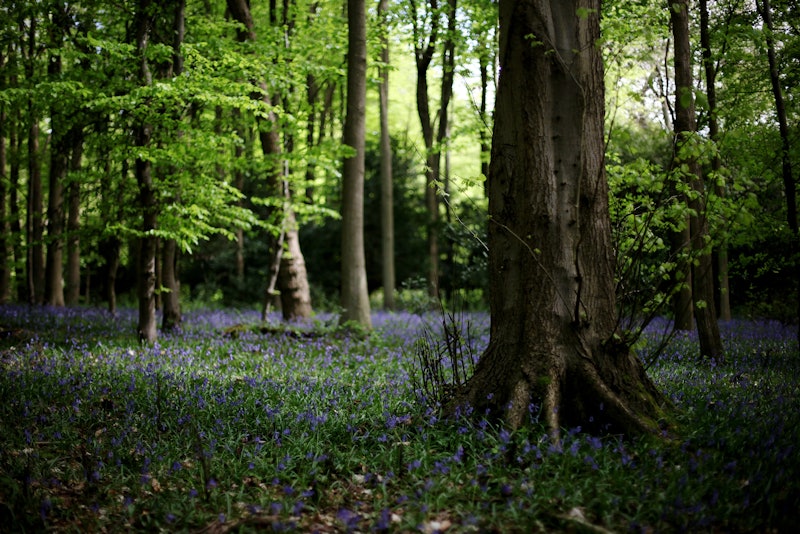Life

It's a bit of a no-brainer that being outside is pretty good for your health; whether it's a park, a forest, or a tree-lined path to the corner store, getting some fresh air feels freaking good. And a new study from the University of East Anglia has re-confirmed that hypothesis: human health seems to be improved with exposure to "green space," as it's called by scientists. More time outside is linked to everything from decreased preterm birth rates to lower levels of type II diabetes, asthma, stroke, and coronary heart disease, possibly because a lot of us use our time in green areas to exercise. And research shows that the more time we spend in nature, watching leaves float by or running around like mad people, the more we physically change our brains.
Brains in adults remain a lot more "plastic," or capable of physical change, than we once thought. This is because of something called 'neuroplasticity', or the ability of neurons to reshape and change in response to stimuli and experiences. Kids' brains are incredibly neuroplastic, but adult brains still retain the ability to alter, and that's the reason that exposure to green spaces can actually change their structure. All that time lying on the grass is doing your brain good. Here are five ways being outside changes your brain.
1
It's Linked With More Grey Matter
A 2018 study of over 250 schoolchildren found that the more exposure they had to green spaces like parks and gardens — what the researchers called "greenness" — the more grey matter their brains possessed. Grey matter, along with white matter, makes up the physical substance of the brain; grey matter is composed of the brain's neural cells, and white matter is what connects them to each other. The more grey matter you have, research has shown, the better your memory will be, the more intelligence you'll show in tests, and the happier you'll be overall.
It's been known for a while that environmental and behavioral factors can change how much grey matter you have. Professional musicians, for instance, have more grey matter in the area of their brain that processes music. But the 2018 study suggests that the brains of kids react positively to the stimulation of green spaces by encouraging neural growth (or that being in a family that encourages exposure to green space is good for the brain). It's not clear why, but it's a big benefit.
2
It Can Shift Your Mood Patterns
Want to get a mood boost? Get yourself to a botanical garden or go to a national park. A study of older adults in 2017 found that, as they walked through urban environments, their moods changed depending on how much green space they encountered. The adults were fitted with headset monitors that showed the electrical activity in their brains as they walked, and their neural responses shifted radically when their location changed from cement and concrete to grass and trees. A lot of this is about association: we don't typically see parks or green spaces as places of stress or anxiety. But it also has implications for mental health, and raises the idea that you'll feel better if your daily walk or commute is green-based.
3
It Can Help Your Attention Span
"Green time," as researchers call time when people are exposed to greenery in their surroundings, seems to have positive effects on the brain's ability to focus. In 2011, researchers found that children who'd been diagnosed with attention hyper-deficit disorder showed reduced symptoms when they were given regular doses of "green time." But that benefit doesn't just apply to kids with ADHD. In 2017 a study of children from birth to age 7 was released that showed that as they grew, their attention levels appeared to be influenced by how much exposure to greenness they had.
The kids who scored best in attention tests at the ages of 4 and 7 were the ones who had the most greenery around their residential neighborhood — likely partially because they came from wealthier, more comfortable families. Access to green space can be a privilege, and studies like this show how important it is for kids to have equal exposure to the natural world.
4
It Can Increase Your Happiness
A fascinating study from 2014 found that, when it comes to adults and their mood, greenery seems to matter more than wealth. The researchers looked at adults across Wisconsin and asked them to rate their depression, anxiety and stress levels, and then looked at how the subjects ranked in terms of race, age, education, income and a host of other factors. And regardless of those factors, green space mattered: whether you were rich or poor, with a PhD or a GED, your mood was better when you lived in a neighborhood with better green space. Humans, it seems, respond incredibly positively to the natural world in their daily lives, particularly around where they live.
5
It Can Help Your Amygdala
The amygdala is one of the "stress centers" of the brain and has a big role in emotional processing. And a study in 2017 found that its physical structure can be changed in adults depending on their exposure to nature and greenery. In particular, the study showed that people with healthier amygdalas tended to live beside forests and heavily tree-populated bits of countryside. The researchers did note that they couldn't be sure whether people with good amygdala function just choose to live nearer trees in general, but there does seem to be a positive link between residing among the pines and having better emotional processing in your brain.
The physical effects of green exposure on the brain all look pretty positive — whether or not they just come from greenery itself, or also stem from making choices and having opportunities that increase your time in nature. Either way, it's a good reason to prioritize a wander through your nearest park ASAP.